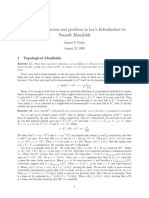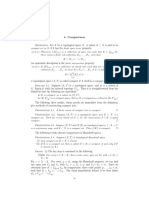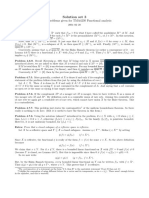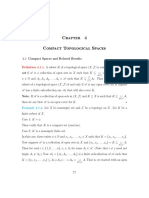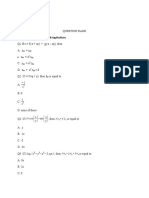0 ratings0% found this document useful (0 votes)
9 viewsA A A 1 A 1 A N N N C N N N
A A A 1 A 1 A N N N C N N N
Uploaded by
shekhawatmahaveerThe document contains solutions to 5 quiz questions about metric spaces and continuous functions between metric spaces.
Question 1 asks about the indicator function of a set A in a metric space X and proves it is continuous if and only if A is both open and closed (clopen).
Question 2 shows that a metric space X is connected if and only if the only continuous functions from X to Z are constant functions.
Question 3 proves that if f is a surjective isometry between metric spaces, then f is a homeomorphism.
Question 4 shows that a point x in a metric space X is a limit point if and only if the subset X minus x is dense in X.
Question 5 proves that
Copyright:
© All Rights Reserved
Available Formats
Download as PDF, TXT or read online from Scribd
A A A 1 A 1 A N N N C N N N
A A A 1 A 1 A N N N C N N N
Uploaded by
shekhawatmahaveer0 ratings0% found this document useful (0 votes)
9 views1 pageThe document contains solutions to 5 quiz questions about metric spaces and continuous functions between metric spaces.
Question 1 asks about the indicator function of a set A in a metric space X and proves it is continuous if and only if A is both open and closed (clopen).
Question 2 shows that a metric space X is connected if and only if the only continuous functions from X to Z are constant functions.
Question 3 proves that if f is a surjective isometry between metric spaces, then f is a homeomorphism.
Question 4 shows that a point x in a metric space X is a limit point if and only if the subset X minus x is dense in X.
Question 5 proves that
Original Description:
Original Title
q2
Copyright
© © All Rights Reserved
Available Formats
PDF, TXT or read online from Scribd
Share this document
Did you find this document useful?
Is this content inappropriate?
The document contains solutions to 5 quiz questions about metric spaces and continuous functions between metric spaces.
Question 1 asks about the indicator function of a set A in a metric space X and proves it is continuous if and only if A is both open and closed (clopen).
Question 2 shows that a metric space X is connected if and only if the only continuous functions from X to Z are constant functions.
Question 3 proves that if f is a surjective isometry between metric spaces, then f is a homeomorphism.
Question 4 shows that a point x in a metric space X is a limit point if and only if the subset X minus x is dense in X.
Question 5 proves that
Copyright:
© All Rights Reserved
Available Formats
Download as PDF, TXT or read online from Scribd
Download as pdf or txt
0 ratings0% found this document useful (0 votes)
9 views1 pageA A A 1 A 1 A N N N C N N N
A A A 1 A 1 A N N N C N N N
Uploaded by
shekhawatmahaveerThe document contains solutions to 5 quiz questions about metric spaces and continuous functions between metric spaces.
Question 1 asks about the indicator function of a set A in a metric space X and proves it is continuous if and only if A is both open and closed (clopen).
Question 2 shows that a metric space X is connected if and only if the only continuous functions from X to Z are constant functions.
Question 3 proves that if f is a surjective isometry between metric spaces, then f is a homeomorphism.
Question 4 shows that a point x in a metric space X is a limit point if and only if the subset X minus x is dense in X.
Question 5 proves that
Copyright:
© All Rights Reserved
Available Formats
Download as PDF, TXT or read online from Scribd
Download as pdf or txt
You are on page 1of 1
Quiz 2
(1) Let X be a metric space A ⊂ X. Suppose 1A : X → R is the indicator function
of the set A. Prove that 1A is continuous iff A is a clopen set.
Solution: If 1A is continuous, then A = 1−1 −1
A ({1}) is closed and A = 1A ((1/2, 3/2))
is open. Suppose A is both open and closed. Let xn → x in X. Then there is
a m such that either xn ∈ A for all n ≥ m or xn ∈ Ac for all n ≥ m. Thus,
f (xn ) = 1 for all n ≥ m or f (xn ) = 0 for all n ≥ m. Thus, f (xn ) → f (x).
(2) A metric space X is connected if and only if constant functions are the only
continuous functions from X into Z.
Solution: If X is connected and f : X → Z is continuous, then f (X) is con-
nected. Since the only connected sets in Z are singleton, f is constant.
If constant functions are the only continuous functions from X into Z, let A be
a clopen set in X, let f = 1A . Since A is clopen, f is continuous. By assumption
f has to be constant, hence A = ∅ or A = X.
(3) Let (X, d) and (Y, ρ) be metric spaces and f : X → Y be a surjective isometry.
Prove that f is a homeomorphism.
Solution: f is an isometry if d(a, b) = ρ(f (a), f (b)). If f (a) = f (b), then
d(f (a), f (b)) = 0 = d(a, b) which implies a = b. Thus, f is one-one. Hence
f −1 exists. Now xn → x in X iff 0 = lim d(xn , x) = lim ρ(f (xn ), f (x)) iff
f (xn ) → f (x). So, f and f −1 is continuous.
(4) Let X be a metric space and x ∈ X. Then x is a limit point of x if and only if
X \ {x} is dense in X.
Solution: If x is a limit point of X, let U be any nonempty open set in X. If
x ∈ U , then U \ {x} ∩ X 6= ∅ ⇒ U ∩ X \ {x} 6= ∅. That is, X \ {x} is dense in
X.
Conversely, if X \ {x} is dense in X, then for any t > 0, Nt (x) meets X \ {x}
⇒ Nt (x) \ {x} meets X. Thus, x is a limit point of X.
(5) Let X and Y be metric spaces and f : X → Y be an isometry. Suppose X is
complete and Y is compact. Prove that f (X) is compact.
Solution: Since Y is compact, it is sufficient to prove that f (X) is closed. Let
(bn ) be a sequence in f (X) such that bn → b. There are an ∈ X such that
f (an ) = bn . Since (bn ) is convergent, (bn ) is Cauchy, hence (an ) is Cauchy as f
is an isometry. Since X is complete, an → a ∈ X, hence f (an ) → f (a). Thus,
b = f (a) ∈ f (X). Thus, f (X) is closed.
You might also like
- Pat English Year 4 Paper 2Document8 pagesPat English Year 4 Paper 2Siti Amalina NadiaNo ratings yet
- Important Theorems - Real AnalysisDocument9 pagesImportant Theorems - Real Analysismmmellyyyy50% (2)
- CSIS Manual v2019.Document111 pagesCSIS Manual v2019.nurse2012100% (1)
- Solutions To Exercises and Problems in Lee's Introduction To Smooth ManifoldsDocument32 pagesSolutions To Exercises and Problems in Lee's Introduction To Smooth ManifoldsGabriel medinaNo ratings yet
- English Is Stupid, Students Are NotDocument28 pagesEnglish Is Stupid, Students Are Notd0m0kunNo ratings yet
- Clay ShonkwilerDocument10 pagesClay Shonkwilerjohn605No ratings yet
- Real Analysis MSC Assignments PDFDocument4 pagesReal Analysis MSC Assignments PDFManojKumarSinghNo ratings yet
- Math 205 Asolutions 3Document19 pagesMath 205 Asolutions 3HANCEL MIRANDA GARCIANo ratings yet
- Solutions To Problem Set 3: Limits and ClosuresDocument4 pagesSolutions To Problem Set 3: Limits and ClosuresanthalyaNo ratings yet
- 10 Compactness in Function Spaces: Ascoli-Arzel A TheoremDocument5 pages10 Compactness in Function Spaces: Ascoli-Arzel A TheoremronalduckNo ratings yet
- 1 04 Top CompactDocument7 pages1 04 Top Compactleandro1281No ratings yet
- Mathematics 121 Final Terence Tao June 10, 1997Document10 pagesMathematics 121 Final Terence Tao June 10, 1997nanndo_00No ratings yet
- ContinuousDocument15 pagesContinuousria paulNo ratings yet
- Bounded Linear MapDocument7 pagesBounded Linear MapP R SAMBHU RAJNo ratings yet
- Math 142, Spring 2012. HW1 Solutions: X Y 1 1 1 R 0 R R 0 R 1 1 1 1 1 1Document1 pageMath 142, Spring 2012. HW1 Solutions: X Y 1 1 1 R 0 R R 0 R 1 1 1 1 1 1Patricia Calvo PérezNo ratings yet
- Compact 1Document9 pagesCompact 1AHALYA ANINo ratings yet
- Exercise 6 From Section 28, Page 181 X Is A Metric Space, So It Is HausdorDocument2 pagesExercise 6 From Section 28, Page 181 X Is A Metric Space, So It Is HausdorParveen DagarNo ratings yet
- MS-E2148 Dynamic OptimizationDocument85 pagesMS-E2148 Dynamic Optimizationpancho_davNo ratings yet
- Applications of Baire Category TheoremDocument11 pagesApplications of Baire Category TheoremUrvashiNo ratings yet
- H. Class Notes of Topology-I, Semester-I, Unit-I..Document3 pagesH. Class Notes of Topology-I, Semester-I, Unit-I..Sahil SharmaNo ratings yet
- CompactDocument5 pagesCompactMwenda DennisNo ratings yet
- Hahn-Banach Theorem: Correspondence # 12Document2 pagesHahn-Banach Theorem: Correspondence # 12EDU CIPANANo ratings yet
- Almost Continuous Function in TopologyDocument39 pagesAlmost Continuous Function in TopologyS.Ramesh Senthil kumarNo ratings yet
- MSM3P22/MSM4P22 Further Complex Variable Theory & General Topology Solutions To Problem Sheet 4Document5 pagesMSM3P22/MSM4P22 Further Complex Variable Theory & General Topology Solutions To Problem Sheet 4Jeoff Libo-onNo ratings yet
- 031 KirkDocument11 pages031 KirkprateekNo ratings yet
- Gelfand CompactnessDocument5 pagesGelfand CompactnessFrank P Murphy HNo ratings yet
- 08 MetricSpaceFunctionsDocument7 pages08 MetricSpaceFunctionsria paulNo ratings yet
- Rudin 4Document20 pagesRudin 4Cody SageNo ratings yet
- 1 Complete Metric SpacesDocument5 pages1 Complete Metric SpacesKuldeepNo ratings yet
- Set Theory by SM SrivastavaDocument37 pagesSet Theory by SM SrivastavaRAMJANNo ratings yet
- CompleteDocument9 pagesCompleteJose MiguelNo ratings yet
- Locally Compact SpacesDocument9 pagesLocally Compact SpacesImam FauziNo ratings yet
- DIV (Divisores) X - Daniel MurfetDocument24 pagesDIV (Divisores) X - Daniel MurfetGerardo ZubiagaNo ratings yet
- Math 730 Homework 8 (Correction 1) : 1 Extra ProblemDocument3 pagesMath 730 Homework 8 (Correction 1) : 1 Extra ProblemPatricia Calvo PérezNo ratings yet
- SP BoundedDocument3 pagesSP BoundedShidka HildaNo ratings yet
- PMA307: Metric Spaces Solutions 5Document2 pagesPMA307: Metric Spaces Solutions 5Tom DavisNo ratings yet
- Hartshorne Algebraic Geometry SolutionsDocument130 pagesHartshorne Algebraic Geometry SolutionsΠΤΟΛΕΜΑΙΟΣ ΗΡΑΚΛΕΙΔΗΣ50% (2)
- Solution Set 3: To Some Problems Given For TMA4230 Functional AnalysisDocument1 pageSolution Set 3: To Some Problems Given For TMA4230 Functional AnalysisJoseph Otaku NaruanimangaNo ratings yet
- M447f17compactness ExtensionDocument7 pagesM447f17compactness ExtensionAlejandro LeónNo ratings yet
- Baire Category TheoremDocument2 pagesBaire Category TheoremRin VanNo ratings yet
- SSRSMI201802V28S01A0007Document9 pagesSSRSMI201802V28S01A0007Bikram KhumanNo ratings yet
- ManifoldDocument7 pagesManifoldeuclidousNo ratings yet
- 7500 CDocument17 pages7500 Csalmanjokar8877No ratings yet
- Manifolds With BoundaryDocument3 pagesManifolds With BoundaryJorge A. SilvaNo ratings yet
- Lecture Notes On Functional Analysis-II by Dr. H. S. Mehta: Continuity of Linear MapsDocument12 pagesLecture Notes On Functional Analysis-II by Dr. H. S. Mehta: Continuity of Linear Mapsblow mindNo ratings yet
- Contractions: 3.1 Metric SpacesDocument10 pagesContractions: 3.1 Metric SpacesDaniel Sastoque BuitragoNo ratings yet
- 712thm Sols Spr16-1g0k71xDocument8 pages712thm Sols Spr16-1g0k71xadell.norouziNo ratings yet
- HW4 SolDocument3 pagesHW4 SolVALENTINA BALLADARES SILVANo ratings yet
- hw9 SolDocument5 pageshw9 SolmukkunameNo ratings yet
- Measurable SelectionDocument17 pagesMeasurable SelectionpochiasdfNo ratings yet
- Hartshorne Algebraic Geometry SolutionsDocument130 pagesHartshorne Algebraic Geometry SolutionsFrank WanNo ratings yet
- Math 142, Spring 2013. HW2 Solutions: A F F Closed in XDocument2 pagesMath 142, Spring 2013. HW2 Solutions: A F F Closed in XPatricia Calvo PérezNo ratings yet
- Lecture 5Document2 pagesLecture 5anchal shuklaNo ratings yet
- Chapter 4Document31 pagesChapter 4haadi khanNo ratings yet
- Closed sets and the Zariski topology: q 1 n 1 n n + α α α 1 α 2 α n α α iDocument68 pagesClosed sets and the Zariski topology: q 1 n 1 n n + α α α 1 α 2 α n α α iNacho IbarraNo ratings yet
- CorrespondencesDocument15 pagesCorrespondencesSamy YNo ratings yet
- Elgenfunction Expansions Associated with Second Order Differential EquationsFrom EverandElgenfunction Expansions Associated with Second Order Differential EquationsNo ratings yet
- Convolution and Equidistribution: Sato-Tate Theorems for Finite-Field Mellin Transforms (AM-180)From EverandConvolution and Equidistribution: Sato-Tate Theorems for Finite-Field Mellin Transforms (AM-180)No ratings yet
- Functional Operators, Volume 2: The Geometry of Orthogonal SpacesFrom EverandFunctional Operators, Volume 2: The Geometry of Orthogonal SpacesNo ratings yet
- Applied Mathematics - MSC Financial ManagementDocument57 pagesApplied Mathematics - MSC Financial ManagementshekhawatmahaveerNo ratings yet
- Balvatika RegistrationDocument1 pageBalvatika RegistrationshekhawatmahaveerNo ratings yet
- Tribology in Industry: J.R. Patel, G.M. DeheriDocument14 pagesTribology in Industry: J.R. Patel, G.M. DeherishekhawatmahaveerNo ratings yet
- A Laser Surface Textured Parallel Thrust BearingDocument8 pagesA Laser Surface Textured Parallel Thrust BearingshekhawatmahaveerNo ratings yet
- Ijpapv13n1 13Document8 pagesIjpapv13n1 13shekhawatmahaveerNo ratings yet
- Pde - 2018Document8 pagesPde - 2018shekhawatmahaveerNo ratings yet
- JFM2021Document13 pagesJFM2021shekhawatmahaveerNo ratings yet
- FinalDocument35 pagesFinalshekhawatmahaveerNo ratings yet
- College Wise Allotted ApllicantsDocument11 pagesCollege Wise Allotted ApllicantsshekhawatmahaveerNo ratings yet
- 12B.Sc., Sem.-V Core Course-302 MathematicsDocument2 pages12B.Sc., Sem.-V Core Course-302 MathematicsshekhawatmahaveerNo ratings yet
- The Fundamental Theorem of Algebra and Complexity Theory: by Steve SmaleDocument36 pagesThe Fundamental Theorem of Algebra and Complexity Theory: by Steve SmaleshekhawatmahaveerNo ratings yet
- Topic: Partial Differentiation & Applications: XX Yy 2 Yy 2 XX 2 YyDocument15 pagesTopic: Partial Differentiation & Applications: XX Yy 2 Yy 2 XX 2 YyshekhawatmahaveerNo ratings yet
- (MPS - BA - TY - CORE - HISTORY) (1-58)Document4 pages(MPS - BA - TY - CORE - HISTORY) (1-58)shekhawatmahaveerNo ratings yet
- Topic: Partial Differentiation & Applications: XX Yy 2 Yy 2 XX 2 YyDocument15 pagesTopic: Partial Differentiation & Applications: XX Yy 2 Yy 2 XX 2 YyshekhawatmahaveerNo ratings yet
- Ma Ha VeerDocument2 pagesMa Ha VeershekhawatmahaveerNo ratings yet
- 14-03-16 To 22-03-16 B - SC - Semester - 6 Mathematics Practical March-2016 PDFDocument19 pages14-03-16 To 22-03-16 B - SC - Semester - 6 Mathematics Practical March-2016 PDFshekhawatmahaveerNo ratings yet
- Renal System and Its Disorders: Key PointsDocument19 pagesRenal System and Its Disorders: Key PointsskNo ratings yet
- Selecting Laboratory Tests To Predict Effectiveness of Retention and Drainage Aid ProgrammesDocument14 pagesSelecting Laboratory Tests To Predict Effectiveness of Retention and Drainage Aid Programmesshalu29No ratings yet
- Usace LetterDocument2 pagesUsace LetterRob PortNo ratings yet
- Topik 3 Ruang Kolaborasi - Alan Setyo Bawono - GKSD ADocument2 pagesTopik 3 Ruang Kolaborasi - Alan Setyo Bawono - GKSD Appg.alanbawono99028No ratings yet
- IT & Systems Case Study - Cisco Systems The Supply Chain StoDocument11 pagesIT & Systems Case Study - Cisco Systems The Supply Chain Stox01001932No ratings yet
- Ocean EnergyDocument25 pagesOcean EnergyMuhammadSaeedTahirNo ratings yet
- Whiteley 2001 Reyner Banham Historian of The Immediate Future PDF (384 515)Document132 pagesWhiteley 2001 Reyner Banham Historian of The Immediate Future PDF (384 515)MarinaNo ratings yet
- MCQ SemiconductorDocument12 pagesMCQ Semiconductormuktadir hosenNo ratings yet
- Statistics Application (Module 3)Document3 pagesStatistics Application (Module 3)ai kawaiiNo ratings yet
- EHV Transmission Line CaseDocument10 pagesEHV Transmission Line Casesumit kumarNo ratings yet
- YTL Corporation Berhad - Annual Report 2013Document239 pagesYTL Corporation Berhad - Annual Report 2013ETDWNo ratings yet
- Makalah Sengketa KontruksiDocument5 pagesMakalah Sengketa KontruksiYogi FarizNo ratings yet
- PACKING LIST - Engl - TemplateDocument1 pagePACKING LIST - Engl - TemplateMikhail MoisakNo ratings yet
- 13 Edition: Strategic Management & Business PolicyDocument27 pages13 Edition: Strategic Management & Business Policybig poppaNo ratings yet
- What Is A CUSUM Chart and When Should I Use OneDocument4 pagesWhat Is A CUSUM Chart and When Should I Use Oneantonio_glzNo ratings yet
- Risk Management: Learning OutcomesDocument16 pagesRisk Management: Learning OutcomesNATURE123No ratings yet
- Ebook File Document 9215Document70 pagesEbook File Document 9215claudette.grice840No ratings yet
- Question Bank ACM - 301 - Principles of AuditingDocument14 pagesQuestion Bank ACM - 301 - Principles of AuditingkirtiinityaNo ratings yet
- Centre For International Governance InnovationDocument6 pagesCentre For International Governance InnovationAkashNo ratings yet
- Sensaguard 18 MM Cylindrical Barrels (Series B Models Only) : Installation InstructionsDocument12 pagesSensaguard 18 MM Cylindrical Barrels (Series B Models Only) : Installation Instructionskaushal kumarNo ratings yet
- Short Research Report: Selfies 2015: Peer Teaching in Medical Sciences Through Video Clips - A Case StudyDocument4 pagesShort Research Report: Selfies 2015: Peer Teaching in Medical Sciences Through Video Clips - A Case StudyMuhammad IjazNo ratings yet
- TABS SiemensDocument22 pagesTABS SiemensOana MocanuNo ratings yet
- MOCK TEST (English-Ii)Document16 pagesMOCK TEST (English-Ii)Thianga MisualNo ratings yet
- Irritant Contact Dermatitis 2Document39 pagesIrritant Contact Dermatitis 2Imam SalehudinNo ratings yet
- Infineon-AN2020-39 REF 62W FLY 1700V SIC-ApplicationNotes-v01 00-ENDocument23 pagesInfineon-AN2020-39 REF 62W FLY 1700V SIC-ApplicationNotes-v01 00-ENMarco FajardoNo ratings yet
- ST 6510Document9 pagesST 6510pacototo1No ratings yet
- Ifad Group AssignmentDocument8 pagesIfad Group AssignmentIsmail DxNo ratings yet



